HR Planning: Analysis of Downsizing Strategies and Impacts
VerifiedAdded on 2021/04/16
|9
|2103
|35
Report
AI Summary
This report provides a comprehensive analysis of HR planning, focusing on the strategies and impacts of downsizing. It explores three primary downsizing approaches: workforce reductions (layoffs, attrition), work redesign (eliminating unnecessary work), and systematic change (holistic organizational change). The report examines the consequences of downsizing on corporate/business strategy, highlighting the negative impacts on employee psychology, behavior, and organizational commitment. Furthermore, it delves into the effects of downsizing on HR planning, including the loss of training investments, disruption of long-term planning, and increased costs. The report references various studies to support its findings, offering a detailed understanding of the complexities and challenges associated with downsizing in human resource management.
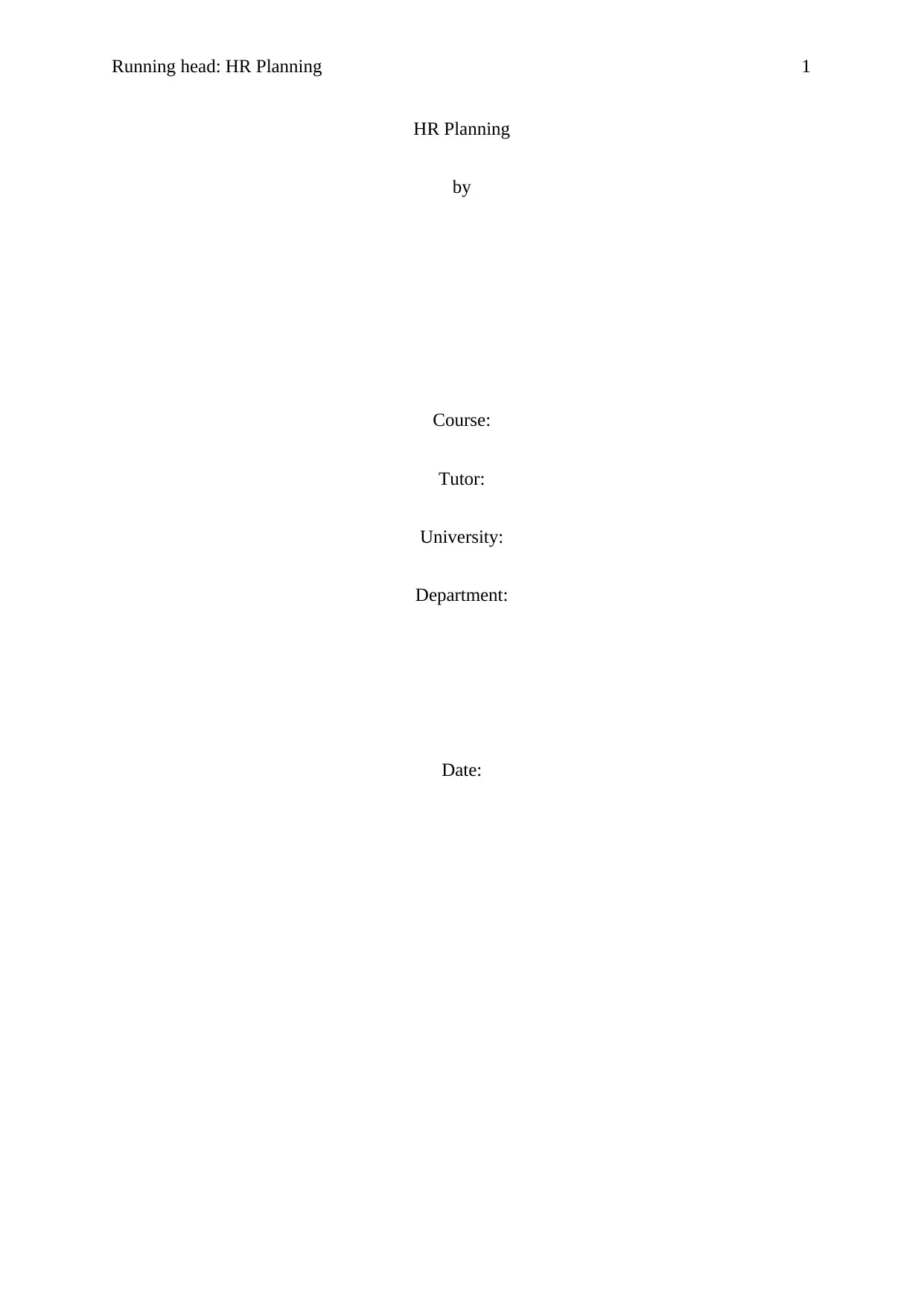
Running head: HR Planning 1
HR Planning
by
Course:
Tutor:
University:
Department:
Date:
HR Planning
by
Course:
Tutor:
University:
Department:
Date:
Paraphrase This Document
Need a fresh take? Get an instant paraphrase of this document with our AI Paraphraser
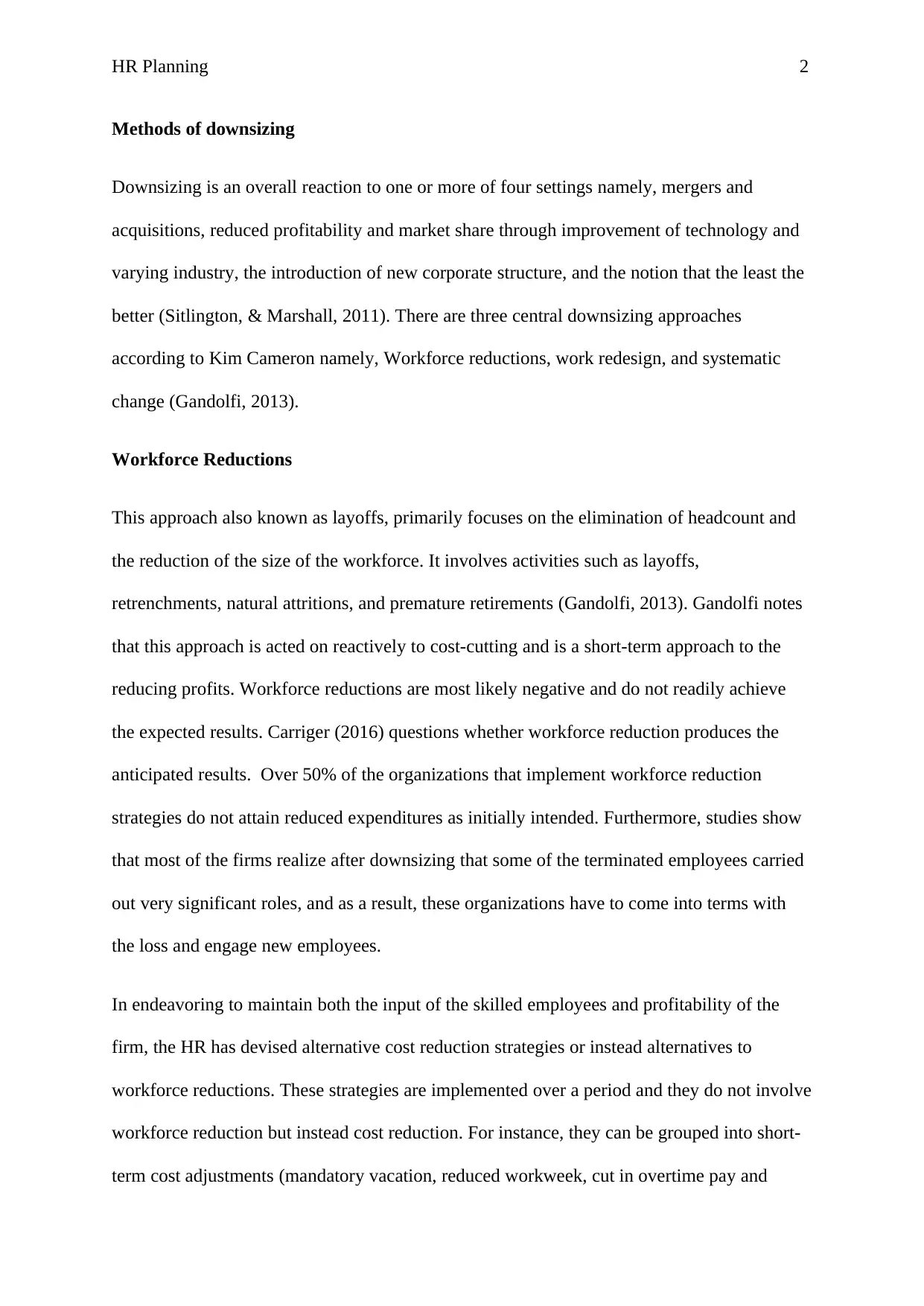
HR Planning 2
Methods of downsizing
Downsizing is an overall reaction to one or more of four settings namely, mergers and
acquisitions, reduced profitability and market share through improvement of technology and
varying industry, the introduction of new corporate structure, and the notion that the least the
better (Sitlington, & Marshall, 2011). There are three central downsizing approaches
according to Kim Cameron namely, Workforce reductions, work redesign, and systematic
change (Gandolfi, 2013).
Workforce Reductions
This approach also known as layoffs, primarily focuses on the elimination of headcount and
the reduction of the size of the workforce. It involves activities such as layoffs,
retrenchments, natural attritions, and premature retirements (Gandolfi, 2013). Gandolfi notes
that this approach is acted on reactively to cost-cutting and is a short-term approach to the
reducing profits. Workforce reductions are most likely negative and do not readily achieve
the expected results. Carriger (2016) questions whether workforce reduction produces the
anticipated results. Over 50% of the organizations that implement workforce reduction
strategies do not attain reduced expenditures as initially intended. Furthermore, studies show
that most of the firms realize after downsizing that some of the terminated employees carried
out very significant roles, and as a result, these organizations have to come into terms with
the loss and engage new employees.
In endeavoring to maintain both the input of the skilled employees and profitability of the
firm, the HR has devised alternative cost reduction strategies or instead alternatives to
workforce reductions. These strategies are implemented over a period and they do not involve
workforce reduction but instead cost reduction. For instance, they can be grouped into short-
term cost adjustments (mandatory vacation, reduced workweek, cut in overtime pay and
Methods of downsizing
Downsizing is an overall reaction to one or more of four settings namely, mergers and
acquisitions, reduced profitability and market share through improvement of technology and
varying industry, the introduction of new corporate structure, and the notion that the least the
better (Sitlington, & Marshall, 2011). There are three central downsizing approaches
according to Kim Cameron namely, Workforce reductions, work redesign, and systematic
change (Gandolfi, 2013).
Workforce Reductions
This approach also known as layoffs, primarily focuses on the elimination of headcount and
the reduction of the size of the workforce. It involves activities such as layoffs,
retrenchments, natural attritions, and premature retirements (Gandolfi, 2013). Gandolfi notes
that this approach is acted on reactively to cost-cutting and is a short-term approach to the
reducing profits. Workforce reductions are most likely negative and do not readily achieve
the expected results. Carriger (2016) questions whether workforce reduction produces the
anticipated results. Over 50% of the organizations that implement workforce reduction
strategies do not attain reduced expenditures as initially intended. Furthermore, studies show
that most of the firms realize after downsizing that some of the terminated employees carried
out very significant roles, and as a result, these organizations have to come into terms with
the loss and engage new employees.
In endeavoring to maintain both the input of the skilled employees and profitability of the
firm, the HR has devised alternative cost reduction strategies or instead alternatives to
workforce reductions. These strategies are implemented over a period and they do not involve
workforce reduction but instead cost reduction. For instance, they can be grouped into short-
term cost adjustments (mandatory vacation, reduced workweek, cut in overtime pay and
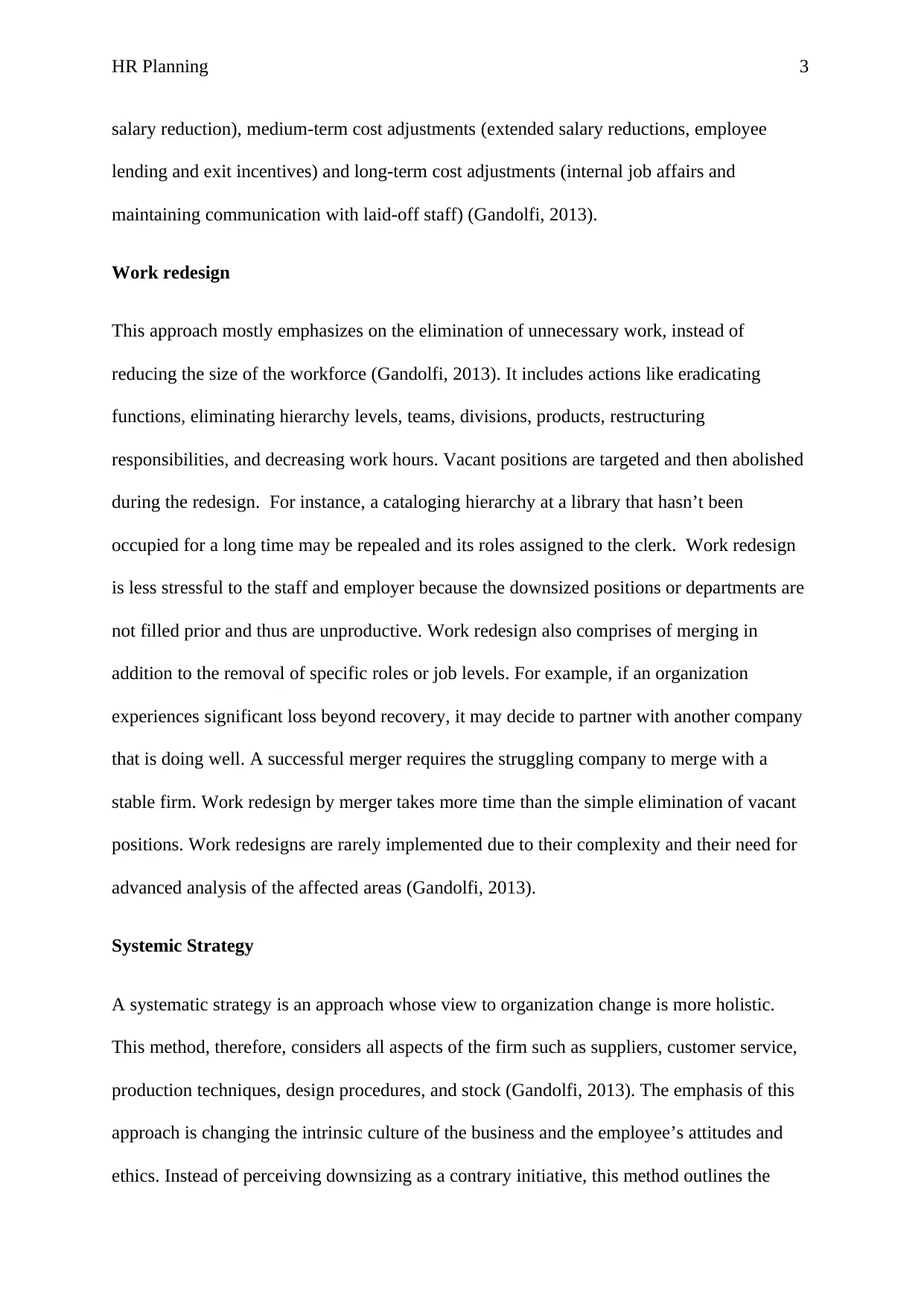
HR Planning 3
salary reduction), medium-term cost adjustments (extended salary reductions, employee
lending and exit incentives) and long-term cost adjustments (internal job affairs and
maintaining communication with laid-off staff) (Gandolfi, 2013).
Work redesign
This approach mostly emphasizes on the elimination of unnecessary work, instead of
reducing the size of the workforce (Gandolfi, 2013). It includes actions like eradicating
functions, eliminating hierarchy levels, teams, divisions, products, restructuring
responsibilities, and decreasing work hours. Vacant positions are targeted and then abolished
during the redesign. For instance, a cataloging hierarchy at a library that hasn’t been
occupied for a long time may be repealed and its roles assigned to the clerk. Work redesign
is less stressful to the staff and employer because the downsized positions or departments are
not filled prior and thus are unproductive. Work redesign also comprises of merging in
addition to the removal of specific roles or job levels. For example, if an organization
experiences significant loss beyond recovery, it may decide to partner with another company
that is doing well. A successful merger requires the struggling company to merge with a
stable firm. Work redesign by merger takes more time than the simple elimination of vacant
positions. Work redesigns are rarely implemented due to their complexity and their need for
advanced analysis of the affected areas (Gandolfi, 2013).
Systemic Strategy
A systematic strategy is an approach whose view to organization change is more holistic.
This method, therefore, considers all aspects of the firm such as suppliers, customer service,
production techniques, design procedures, and stock (Gandolfi, 2013). The emphasis of this
approach is changing the intrinsic culture of the business and the employee’s attitudes and
ethics. Instead of perceiving downsizing as a contrary initiative, this method outlines the
salary reduction), medium-term cost adjustments (extended salary reductions, employee
lending and exit incentives) and long-term cost adjustments (internal job affairs and
maintaining communication with laid-off staff) (Gandolfi, 2013).
Work redesign
This approach mostly emphasizes on the elimination of unnecessary work, instead of
reducing the size of the workforce (Gandolfi, 2013). It includes actions like eradicating
functions, eliminating hierarchy levels, teams, divisions, products, restructuring
responsibilities, and decreasing work hours. Vacant positions are targeted and then abolished
during the redesign. For instance, a cataloging hierarchy at a library that hasn’t been
occupied for a long time may be repealed and its roles assigned to the clerk. Work redesign
is less stressful to the staff and employer because the downsized positions or departments are
not filled prior and thus are unproductive. Work redesign also comprises of merging in
addition to the removal of specific roles or job levels. For example, if an organization
experiences significant loss beyond recovery, it may decide to partner with another company
that is doing well. A successful merger requires the struggling company to merge with a
stable firm. Work redesign by merger takes more time than the simple elimination of vacant
positions. Work redesigns are rarely implemented due to their complexity and their need for
advanced analysis of the affected areas (Gandolfi, 2013).
Systemic Strategy
A systematic strategy is an approach whose view to organization change is more holistic.
This method, therefore, considers all aspects of the firm such as suppliers, customer service,
production techniques, design procedures, and stock (Gandolfi, 2013). The emphasis of this
approach is changing the intrinsic culture of the business and the employee’s attitudes and
ethics. Instead of perceiving downsizing as a contrary initiative, this method outlines the
⊘ This is a preview!⊘
Do you want full access?
Subscribe today to unlock all pages.

Trusted by 1+ million students worldwide
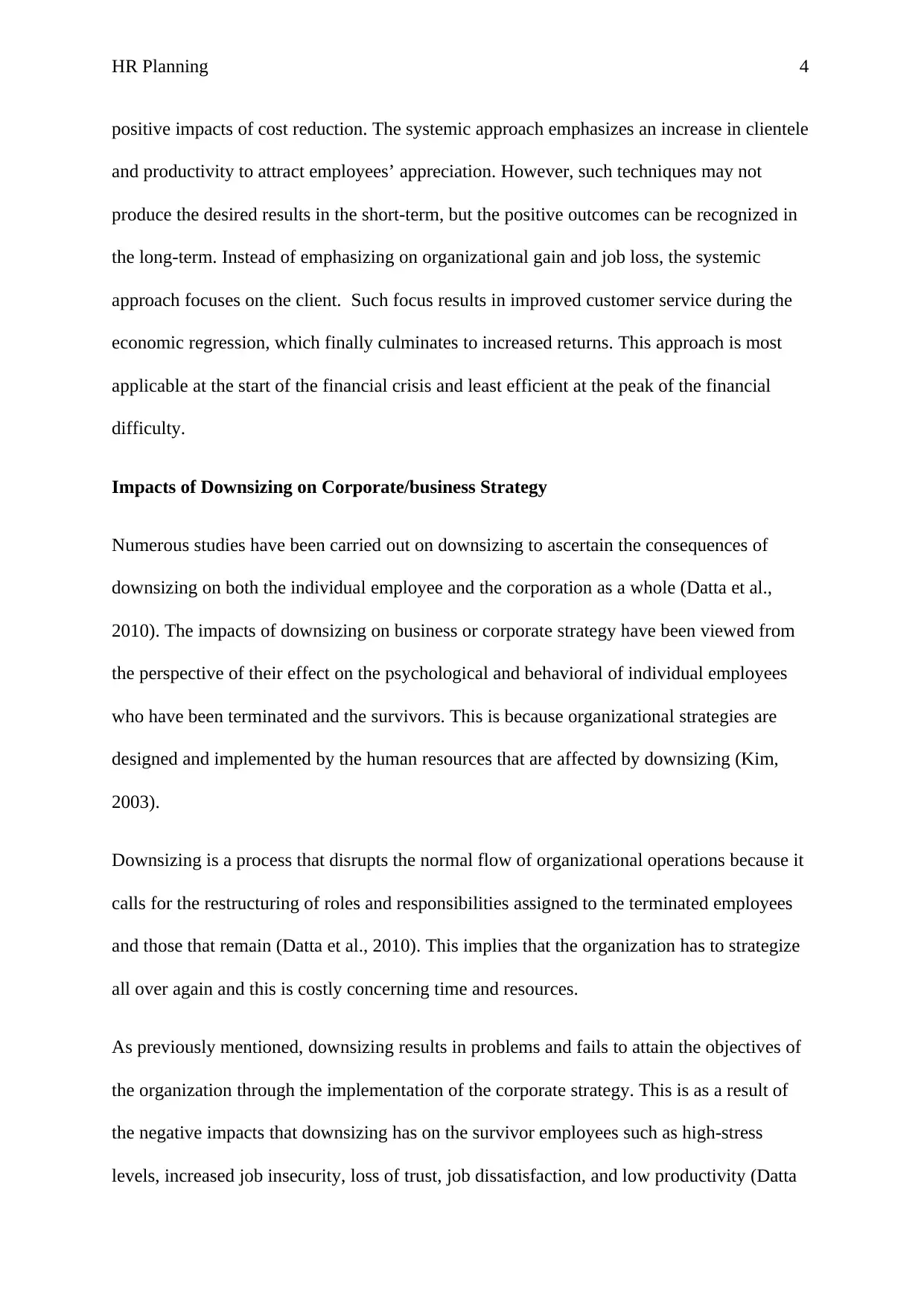
HR Planning 4
positive impacts of cost reduction. The systemic approach emphasizes an increase in clientele
and productivity to attract employees’ appreciation. However, such techniques may not
produce the desired results in the short-term, but the positive outcomes can be recognized in
the long-term. Instead of emphasizing on organizational gain and job loss, the systemic
approach focuses on the client. Such focus results in improved customer service during the
economic regression, which finally culminates to increased returns. This approach is most
applicable at the start of the financial crisis and least efficient at the peak of the financial
difficulty.
Impacts of Downsizing on Corporate/business Strategy
Numerous studies have been carried out on downsizing to ascertain the consequences of
downsizing on both the individual employee and the corporation as a whole (Datta et al.,
2010). The impacts of downsizing on business or corporate strategy have been viewed from
the perspective of their effect on the psychological and behavioral of individual employees
who have been terminated and the survivors. This is because organizational strategies are
designed and implemented by the human resources that are affected by downsizing (Kim,
2003).
Downsizing is a process that disrupts the normal flow of organizational operations because it
calls for the restructuring of roles and responsibilities assigned to the terminated employees
and those that remain (Datta et al., 2010). This implies that the organization has to strategize
all over again and this is costly concerning time and resources.
As previously mentioned, downsizing results in problems and fails to attain the objectives of
the organization through the implementation of the corporate strategy. This is as a result of
the negative impacts that downsizing has on the survivor employees such as high-stress
levels, increased job insecurity, loss of trust, job dissatisfaction, and low productivity (Datta
positive impacts of cost reduction. The systemic approach emphasizes an increase in clientele
and productivity to attract employees’ appreciation. However, such techniques may not
produce the desired results in the short-term, but the positive outcomes can be recognized in
the long-term. Instead of emphasizing on organizational gain and job loss, the systemic
approach focuses on the client. Such focus results in improved customer service during the
economic regression, which finally culminates to increased returns. This approach is most
applicable at the start of the financial crisis and least efficient at the peak of the financial
difficulty.
Impacts of Downsizing on Corporate/business Strategy
Numerous studies have been carried out on downsizing to ascertain the consequences of
downsizing on both the individual employee and the corporation as a whole (Datta et al.,
2010). The impacts of downsizing on business or corporate strategy have been viewed from
the perspective of their effect on the psychological and behavioral of individual employees
who have been terminated and the survivors. This is because organizational strategies are
designed and implemented by the human resources that are affected by downsizing (Kim,
2003).
Downsizing is a process that disrupts the normal flow of organizational operations because it
calls for the restructuring of roles and responsibilities assigned to the terminated employees
and those that remain (Datta et al., 2010). This implies that the organization has to strategize
all over again and this is costly concerning time and resources.
As previously mentioned, downsizing results in problems and fails to attain the objectives of
the organization through the implementation of the corporate strategy. This is as a result of
the negative impacts that downsizing has on the survivor employees such as high-stress
levels, increased job insecurity, loss of trust, job dissatisfaction, and low productivity (Datta
Paraphrase This Document
Need a fresh take? Get an instant paraphrase of this document with our AI Paraphraser
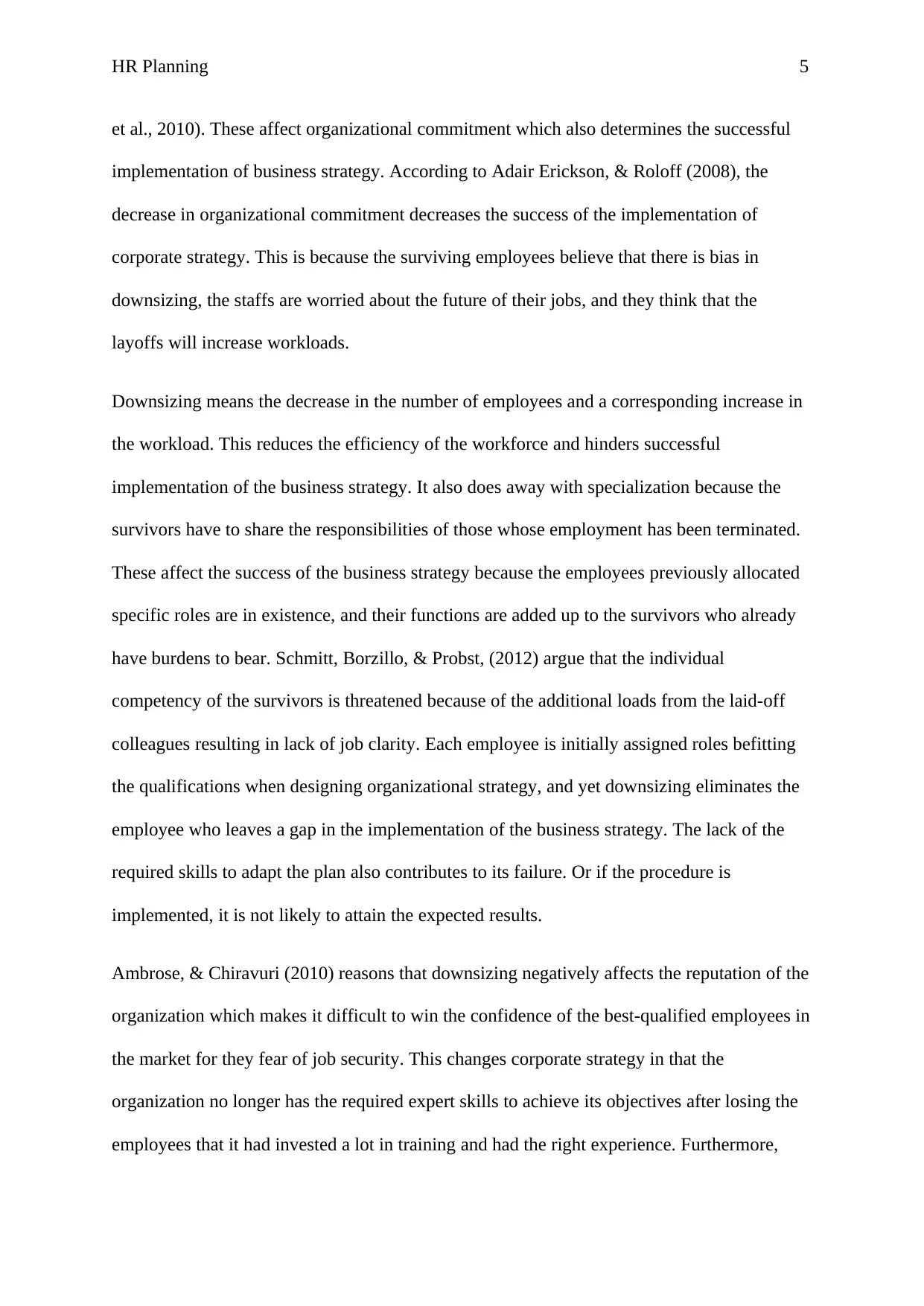
HR Planning 5
et al., 2010). These affect organizational commitment which also determines the successful
implementation of business strategy. According to Adair Erickson, & Roloff (2008), the
decrease in organizational commitment decreases the success of the implementation of
corporate strategy. This is because the surviving employees believe that there is bias in
downsizing, the staffs are worried about the future of their jobs, and they think that the
layoffs will increase workloads.
Downsizing means the decrease in the number of employees and a corresponding increase in
the workload. This reduces the efficiency of the workforce and hinders successful
implementation of the business strategy. It also does away with specialization because the
survivors have to share the responsibilities of those whose employment has been terminated.
These affect the success of the business strategy because the employees previously allocated
specific roles are in existence, and their functions are added up to the survivors who already
have burdens to bear. Schmitt, Borzillo, & Probst, (2012) argue that the individual
competency of the survivors is threatened because of the additional loads from the laid-off
colleagues resulting in lack of job clarity. Each employee is initially assigned roles befitting
the qualifications when designing organizational strategy, and yet downsizing eliminates the
employee who leaves a gap in the implementation of the business strategy. The lack of the
required skills to adapt the plan also contributes to its failure. Or if the procedure is
implemented, it is not likely to attain the expected results.
Ambrose, & Chiravuri (2010) reasons that downsizing negatively affects the reputation of the
organization which makes it difficult to win the confidence of the best-qualified employees in
the market for they fear of job security. This changes corporate strategy in that the
organization no longer has the required expert skills to achieve its objectives after losing the
employees that it had invested a lot in training and had the right experience. Furthermore,
et al., 2010). These affect organizational commitment which also determines the successful
implementation of business strategy. According to Adair Erickson, & Roloff (2008), the
decrease in organizational commitment decreases the success of the implementation of
corporate strategy. This is because the surviving employees believe that there is bias in
downsizing, the staffs are worried about the future of their jobs, and they think that the
layoffs will increase workloads.
Downsizing means the decrease in the number of employees and a corresponding increase in
the workload. This reduces the efficiency of the workforce and hinders successful
implementation of the business strategy. It also does away with specialization because the
survivors have to share the responsibilities of those whose employment has been terminated.
These affect the success of the business strategy because the employees previously allocated
specific roles are in existence, and their functions are added up to the survivors who already
have burdens to bear. Schmitt, Borzillo, & Probst, (2012) argue that the individual
competency of the survivors is threatened because of the additional loads from the laid-off
colleagues resulting in lack of job clarity. Each employee is initially assigned roles befitting
the qualifications when designing organizational strategy, and yet downsizing eliminates the
employee who leaves a gap in the implementation of the business strategy. The lack of the
required skills to adapt the plan also contributes to its failure. Or if the procedure is
implemented, it is not likely to attain the expected results.
Ambrose, & Chiravuri (2010) reasons that downsizing negatively affects the reputation of the
organization which makes it difficult to win the confidence of the best-qualified employees in
the market for they fear of job security. This changes corporate strategy in that the
organization no longer has the required expert skills to achieve its objectives after losing the
employees that it had invested a lot in training and had the right experience. Furthermore,
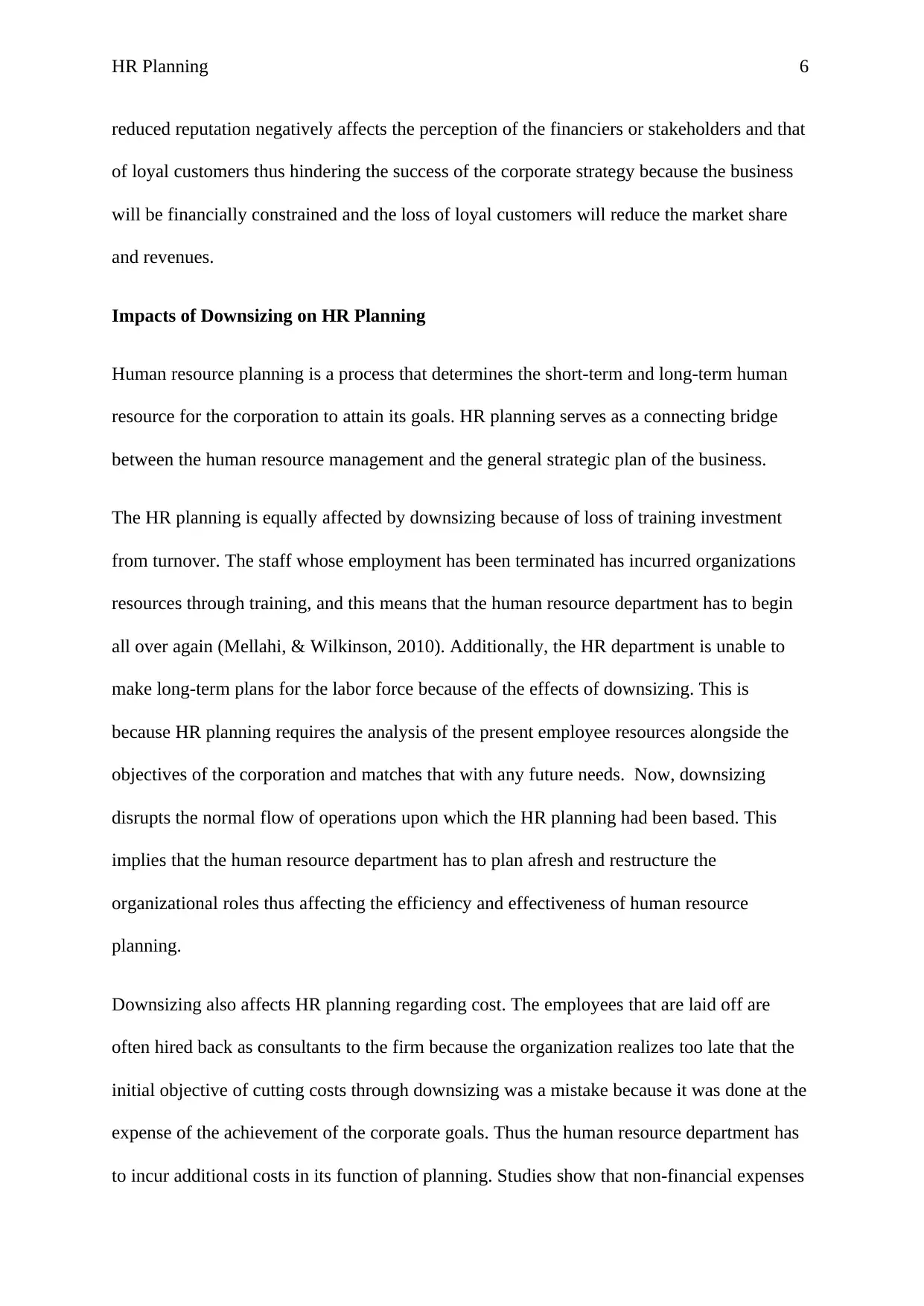
HR Planning 6
reduced reputation negatively affects the perception of the financiers or stakeholders and that
of loyal customers thus hindering the success of the corporate strategy because the business
will be financially constrained and the loss of loyal customers will reduce the market share
and revenues.
Impacts of Downsizing on HR Planning
Human resource planning is a process that determines the short-term and long-term human
resource for the corporation to attain its goals. HR planning serves as a connecting bridge
between the human resource management and the general strategic plan of the business.
The HR planning is equally affected by downsizing because of loss of training investment
from turnover. The staff whose employment has been terminated has incurred organizations
resources through training, and this means that the human resource department has to begin
all over again (Mellahi, & Wilkinson, 2010). Additionally, the HR department is unable to
make long-term plans for the labor force because of the effects of downsizing. This is
because HR planning requires the analysis of the present employee resources alongside the
objectives of the corporation and matches that with any future needs. Now, downsizing
disrupts the normal flow of operations upon which the HR planning had been based. This
implies that the human resource department has to plan afresh and restructure the
organizational roles thus affecting the efficiency and effectiveness of human resource
planning.
Downsizing also affects HR planning regarding cost. The employees that are laid off are
often hired back as consultants to the firm because the organization realizes too late that the
initial objective of cutting costs through downsizing was a mistake because it was done at the
expense of the achievement of the corporate goals. Thus the human resource department has
to incur additional costs in its function of planning. Studies show that non-financial expenses
reduced reputation negatively affects the perception of the financiers or stakeholders and that
of loyal customers thus hindering the success of the corporate strategy because the business
will be financially constrained and the loss of loyal customers will reduce the market share
and revenues.
Impacts of Downsizing on HR Planning
Human resource planning is a process that determines the short-term and long-term human
resource for the corporation to attain its goals. HR planning serves as a connecting bridge
between the human resource management and the general strategic plan of the business.
The HR planning is equally affected by downsizing because of loss of training investment
from turnover. The staff whose employment has been terminated has incurred organizations
resources through training, and this means that the human resource department has to begin
all over again (Mellahi, & Wilkinson, 2010). Additionally, the HR department is unable to
make long-term plans for the labor force because of the effects of downsizing. This is
because HR planning requires the analysis of the present employee resources alongside the
objectives of the corporation and matches that with any future needs. Now, downsizing
disrupts the normal flow of operations upon which the HR planning had been based. This
implies that the human resource department has to plan afresh and restructure the
organizational roles thus affecting the efficiency and effectiveness of human resource
planning.
Downsizing also affects HR planning regarding cost. The employees that are laid off are
often hired back as consultants to the firm because the organization realizes too late that the
initial objective of cutting costs through downsizing was a mistake because it was done at the
expense of the achievement of the corporate goals. Thus the human resource department has
to incur additional costs in its function of planning. Studies show that non-financial expenses
⊘ This is a preview!⊘
Do you want full access?
Subscribe today to unlock all pages.

Trusted by 1+ million students worldwide

HR Planning 7
are usually disregarded when downsizing and yet they are significant in HR planning. Costs
like the loss of outstanding talent and disruption of organizational memory (Gong, &
Greenwood, 2012) are part of the reasons for failed downsizing and hr planning.
are usually disregarded when downsizing and yet they are significant in HR planning. Costs
like the loss of outstanding talent and disruption of organizational memory (Gong, &
Greenwood, 2012) are part of the reasons for failed downsizing and hr planning.
Paraphrase This Document
Need a fresh take? Get an instant paraphrase of this document with our AI Paraphraser
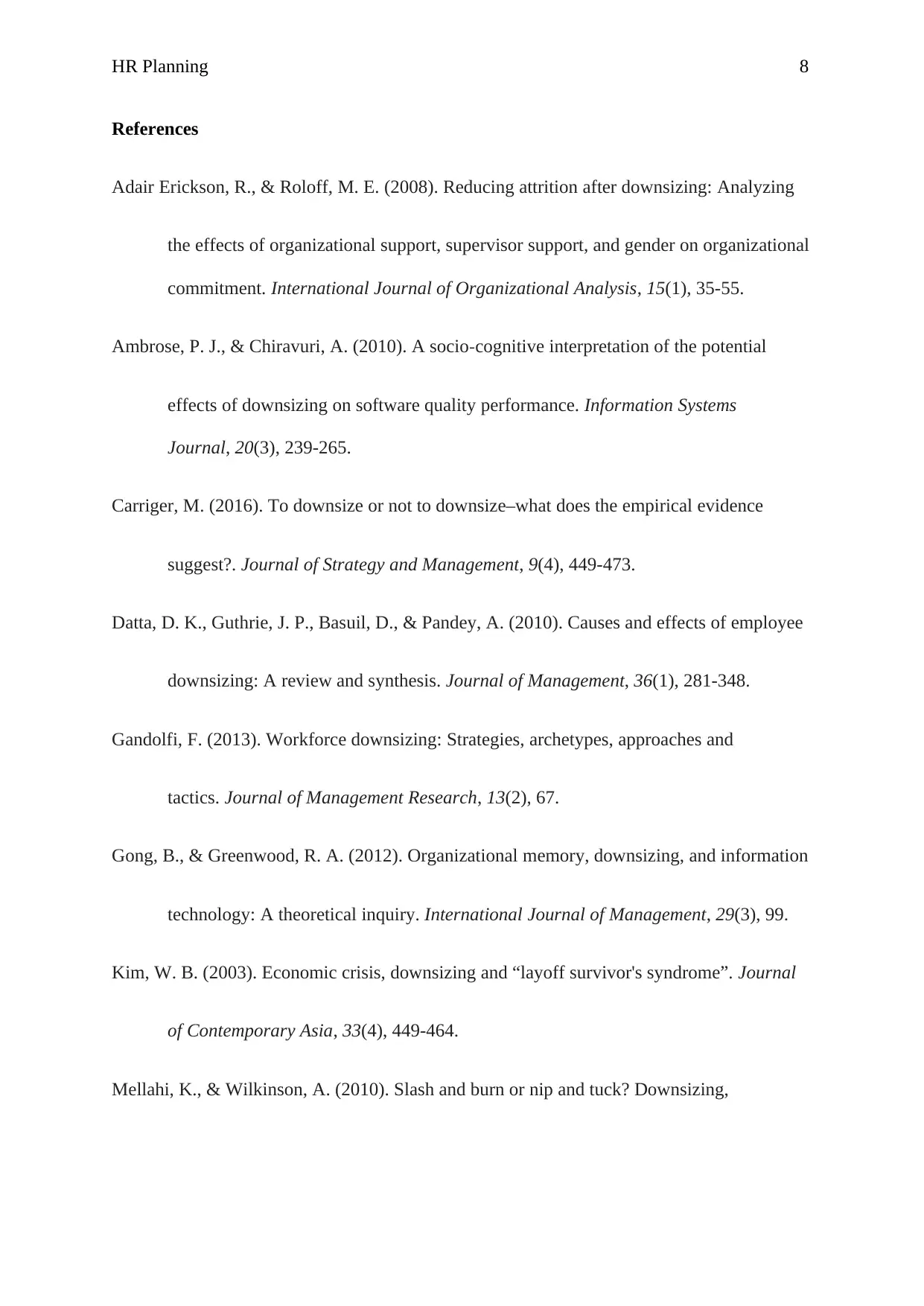
HR Planning 8
References
Adair Erickson, R., & Roloff, M. E. (2008). Reducing attrition after downsizing: Analyzing
the effects of organizational support, supervisor support, and gender on organizational
commitment. International Journal of Organizational Analysis, 15(1), 35-55.
Ambrose, P. J., & Chiravuri, A. (2010). A socio‐cognitive interpretation of the potential
effects of downsizing on software quality performance. Information Systems
Journal, 20(3), 239-265.
Carriger, M. (2016). To downsize or not to downsize–what does the empirical evidence
suggest?. Journal of Strategy and Management, 9(4), 449-473.
Datta, D. K., Guthrie, J. P., Basuil, D., & Pandey, A. (2010). Causes and effects of employee
downsizing: A review and synthesis. Journal of Management, 36(1), 281-348.
Gandolfi, F. (2013). Workforce downsizing: Strategies, archetypes, approaches and
tactics. Journal of Management Research, 13(2), 67.
Gong, B., & Greenwood, R. A. (2012). Organizational memory, downsizing, and information
technology: A theoretical inquiry. International Journal of Management, 29(3), 99.
Kim, W. B. (2003). Economic crisis, downsizing and “layoff survivor's syndrome”. Journal
of Contemporary Asia, 33(4), 449-464.
Mellahi, K., & Wilkinson, A. (2010). Slash and burn or nip and tuck? Downsizing,
References
Adair Erickson, R., & Roloff, M. E. (2008). Reducing attrition after downsizing: Analyzing
the effects of organizational support, supervisor support, and gender on organizational
commitment. International Journal of Organizational Analysis, 15(1), 35-55.
Ambrose, P. J., & Chiravuri, A. (2010). A socio‐cognitive interpretation of the potential
effects of downsizing on software quality performance. Information Systems
Journal, 20(3), 239-265.
Carriger, M. (2016). To downsize or not to downsize–what does the empirical evidence
suggest?. Journal of Strategy and Management, 9(4), 449-473.
Datta, D. K., Guthrie, J. P., Basuil, D., & Pandey, A. (2010). Causes and effects of employee
downsizing: A review and synthesis. Journal of Management, 36(1), 281-348.
Gandolfi, F. (2013). Workforce downsizing: Strategies, archetypes, approaches and
tactics. Journal of Management Research, 13(2), 67.
Gong, B., & Greenwood, R. A. (2012). Organizational memory, downsizing, and information
technology: A theoretical inquiry. International Journal of Management, 29(3), 99.
Kim, W. B. (2003). Economic crisis, downsizing and “layoff survivor's syndrome”. Journal
of Contemporary Asia, 33(4), 449-464.
Mellahi, K., & Wilkinson, A. (2010). Slash and burn or nip and tuck? Downsizing,
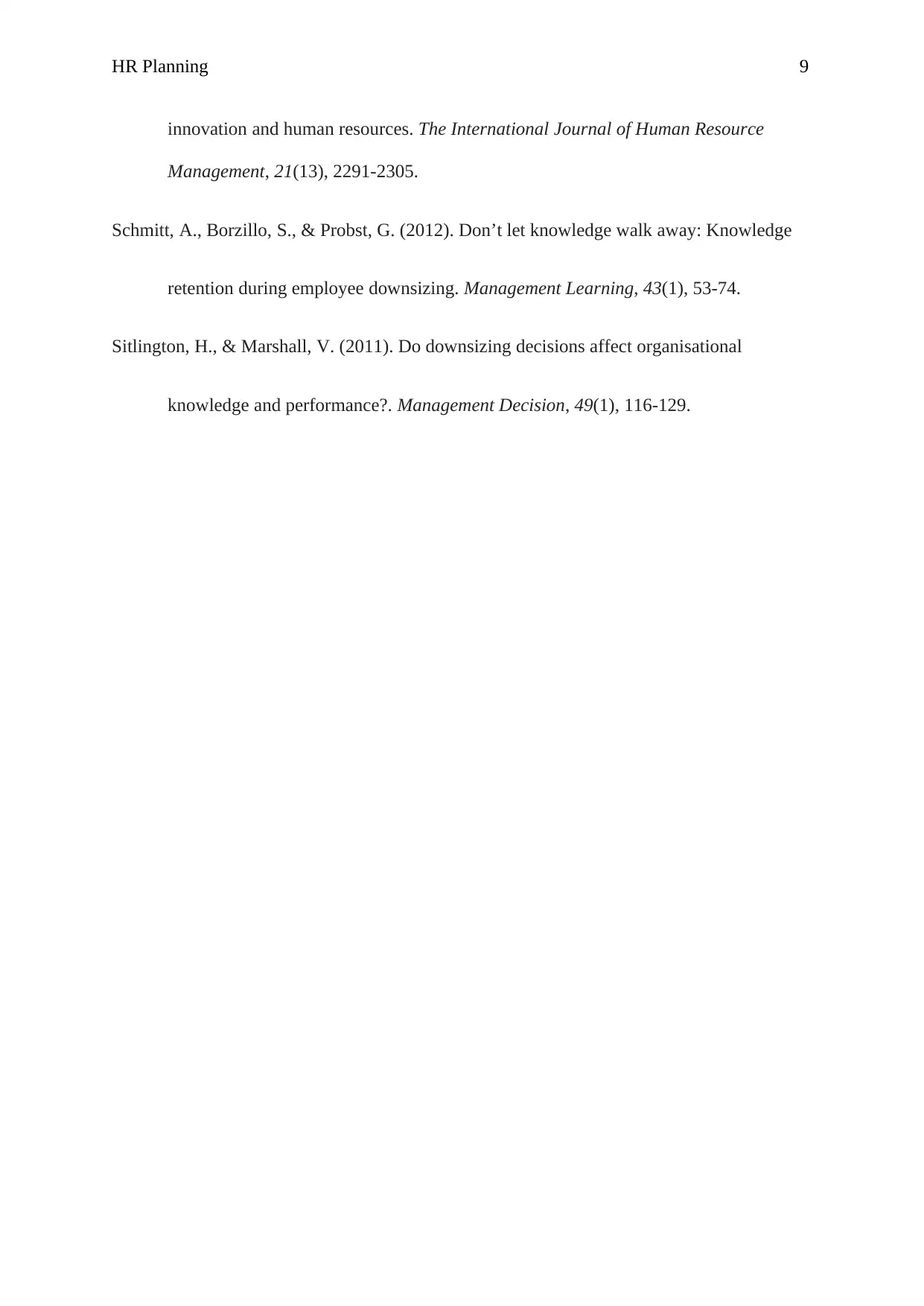
HR Planning 9
innovation and human resources. The International Journal of Human Resource
Management, 21(13), 2291-2305.
Schmitt, A., Borzillo, S., & Probst, G. (2012). Don’t let knowledge walk away: Knowledge
retention during employee downsizing. Management Learning, 43(1), 53-74.
Sitlington, H., & Marshall, V. (2011). Do downsizing decisions affect organisational
knowledge and performance?. Management Decision, 49(1), 116-129.
innovation and human resources. The International Journal of Human Resource
Management, 21(13), 2291-2305.
Schmitt, A., Borzillo, S., & Probst, G. (2012). Don’t let knowledge walk away: Knowledge
retention during employee downsizing. Management Learning, 43(1), 53-74.
Sitlington, H., & Marshall, V. (2011). Do downsizing decisions affect organisational
knowledge and performance?. Management Decision, 49(1), 116-129.
⊘ This is a preview!⊘
Do you want full access?
Subscribe today to unlock all pages.

Trusted by 1+ million students worldwide
1 out of 9
Related Documents
Your All-in-One AI-Powered Toolkit for Academic Success.
+13062052269
info@desklib.com
Available 24*7 on WhatsApp / Email
![[object Object]](/_next/static/media/star-bottom.7253800d.svg)
Unlock your academic potential
Copyright © 2020–2025 A2Z Services. All Rights Reserved. Developed and managed by ZUCOL.





